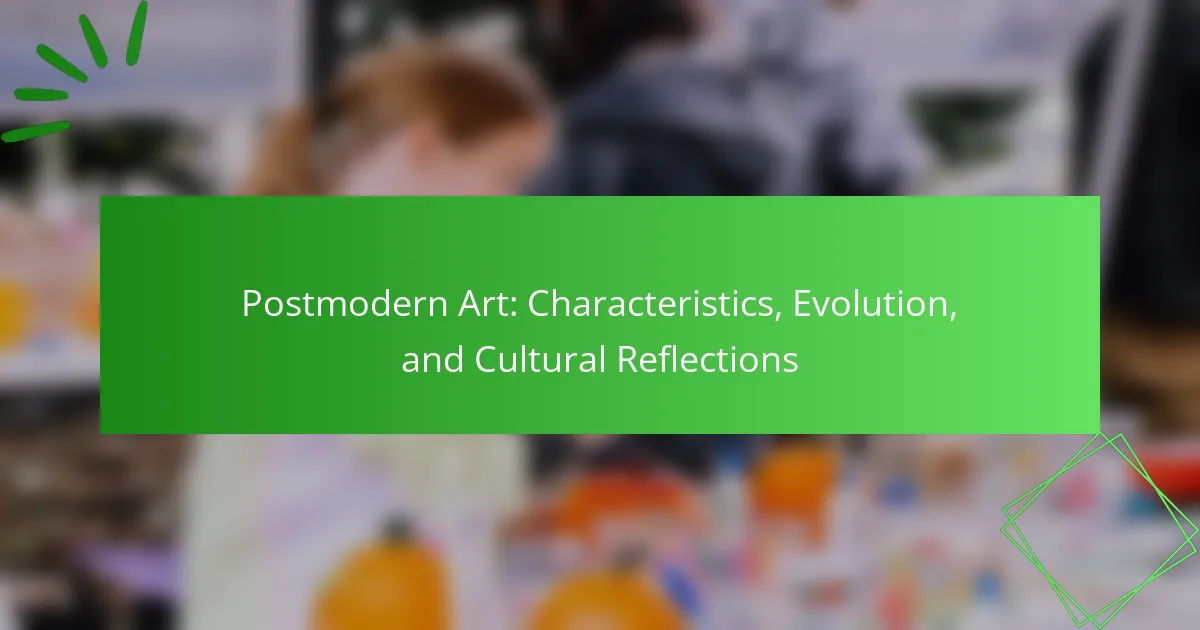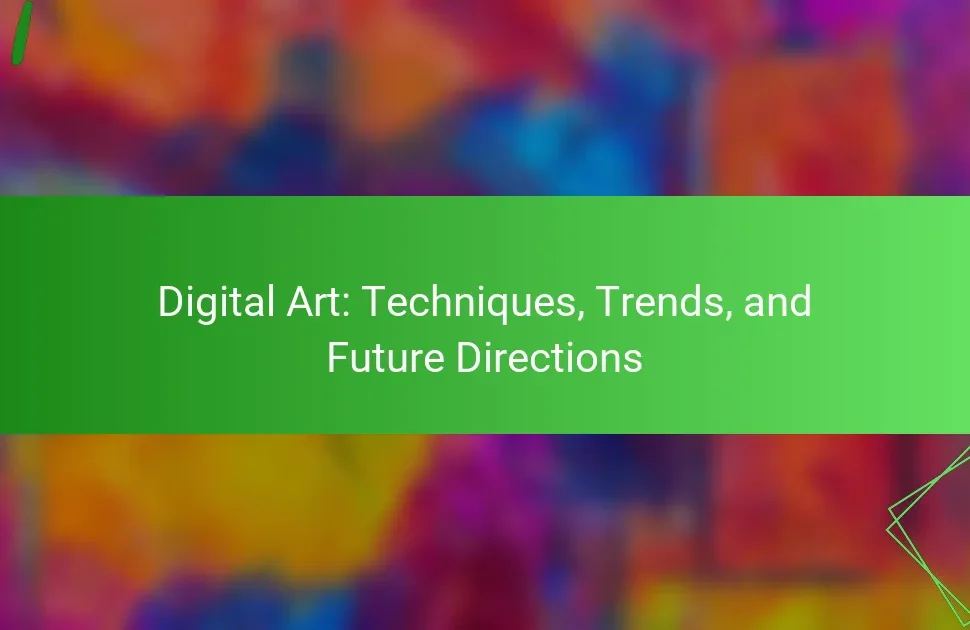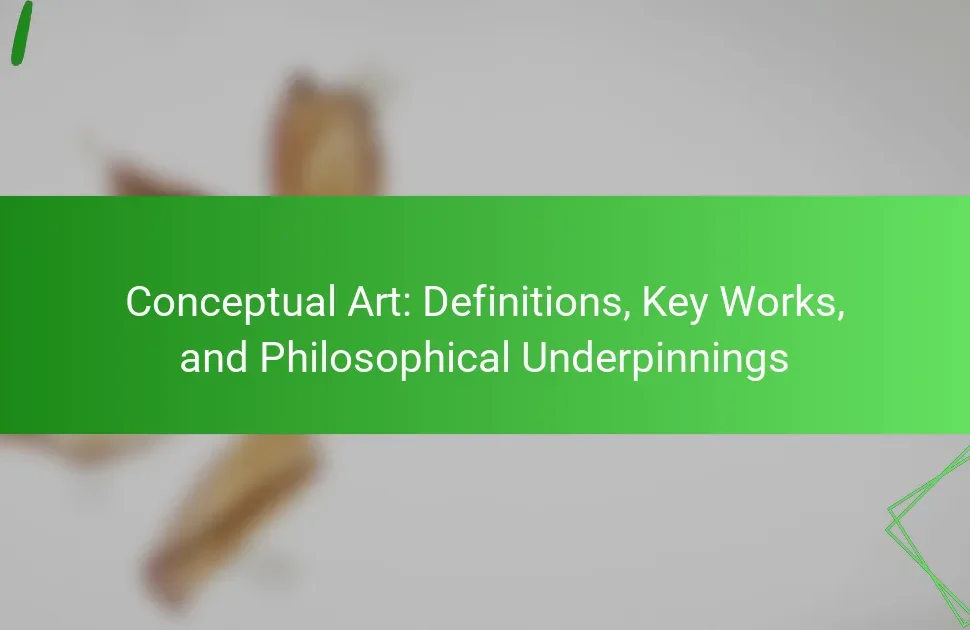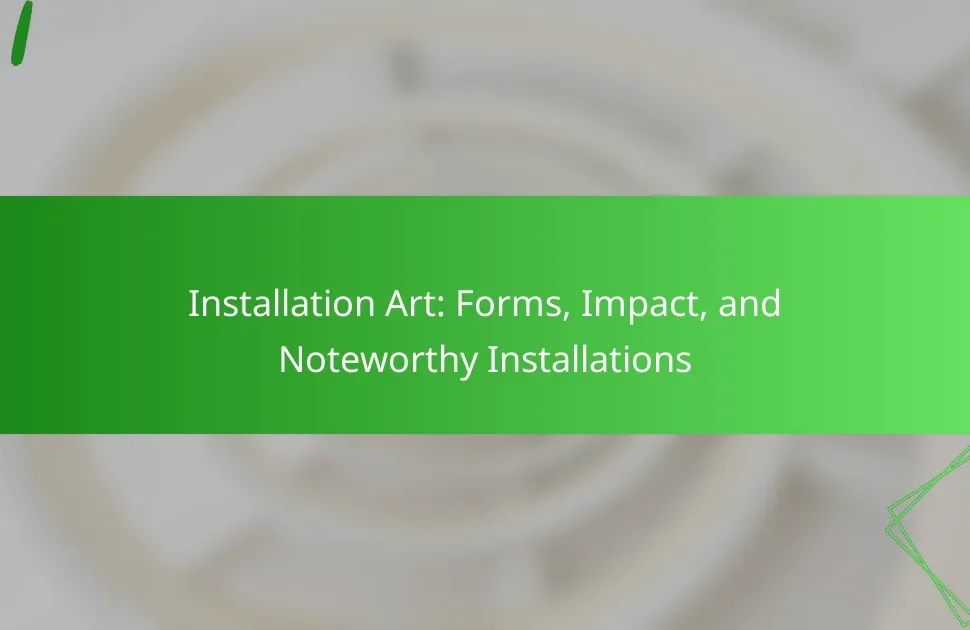Postmodern art challenges traditional norms and reflects contemporary societal issues. It features diverse styles, embraces pluralism, and incorporates technology. The evolution of this movement highlights its adaptability and relevance, while its unique attributes, such as irony and pastiche, provoke critical engagement. Understanding postmodern art involves exploring its cultural critiques and addressing common misconceptions surrounding its meaning and intent.
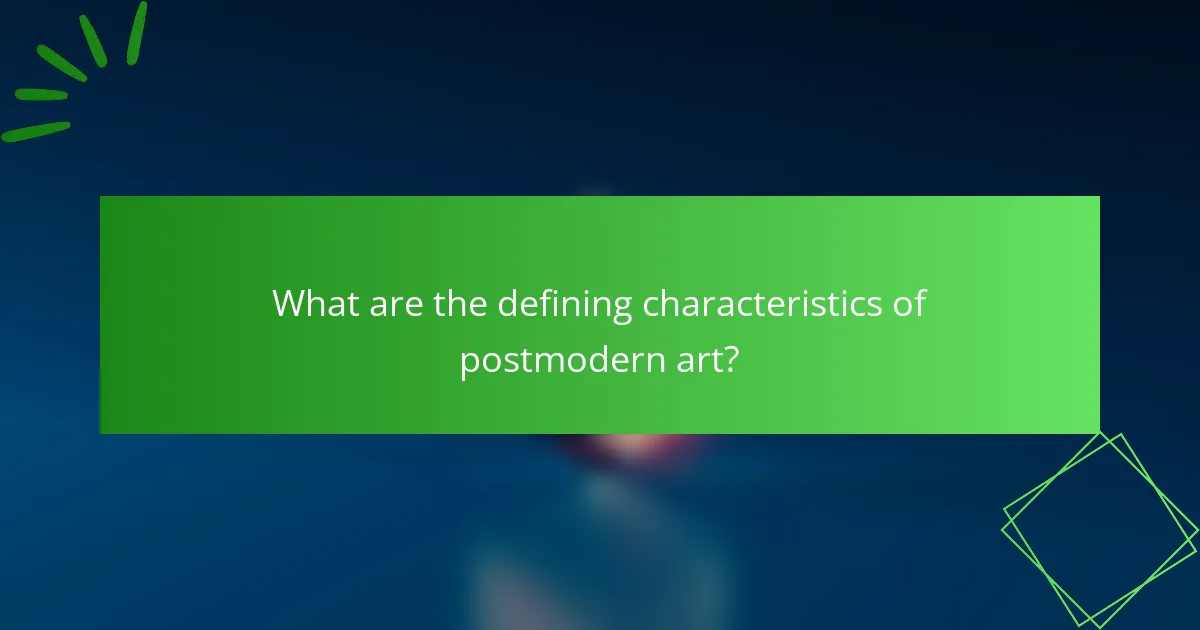
What are the defining characteristics of postmodern art?
Postmodern art is characterized by its diverse styles, irony, and rejection of traditional norms. It often embraces pluralism, blending high and low culture, and challenges established narratives. This art movement reflects contemporary societal issues and encourages viewer interpretation. Unique attributes include the use of mixed media and pastiche, while rare attributes may involve site-specific installations.
How does postmodern art differ from modern art?
Postmodern art differs from modern art by embracing diversity, irony, and questioning established norms. Modern art focused on innovation and abstraction, while postmodern art incorporates eclectic styles and cultural references. Postmodern artists often challenge the notion of originality, reflecting a pluralistic society. This evolution showcases a shift from a singular narrative to multiple perspectives, emphasizing context and interpretation.
What role does irony play in postmodern art?
Irony plays a crucial role in postmodern art by challenging traditional narratives and expectations. It serves as a tool for critique, allowing artists to highlight contradictions in society and culture. This approach often subverts established meanings, creating layers of interpretation. Irony reflects the fragmented nature of postmodernism, where certainty is questioned and multiple perspectives coexist. Artists like Andy Warhol and Cindy Sherman utilize irony to comment on consumerism and identity, engaging viewers in a dialogue about authenticity and representation.
Which techniques are commonly used in postmodern art?
Common techniques in postmodern art include appropriation, pastiche, and irony. These methods challenge traditional art forms and reflect cultural complexities. Appropriation involves reusing existing works, while pastiche combines styles to create new meanings. Irony often critiques societal norms, showcasing the playful nature of postmodernism.

How has postmodern art evolved since its emergence?
Postmodern art has evolved through diverse styles and cultural critiques since its emergence. Initially characterized by a rejection of modernism, it embraced pluralism and irony. In the 1980s, postmodern art incorporated technology and media, reflecting societal changes. Today, it engages with global issues, emphasizing identity and social commentary. This evolution highlights its adaptability and relevance in contemporary discourse.
What major movements influenced postmodern art?
Postmodern art was influenced by movements such as Dadaism, Surrealism, and Minimalism. These movements challenged traditional artistic conventions and embraced diverse forms of expression. Dadaism introduced absurdity and anti-art sentiments, while Surrealism explored the unconscious mind. Minimalism emphasized simplicity and objecthood. Collectively, these influences reshaped the art landscape, reflecting cultural shifts and questioning established norms.
Which key artists have shaped the postmodern art landscape?
Key artists shaping the postmodern art landscape include Andy Warhol, Jean-Michel Basquiat, and Cindy Sherman. Their diverse styles and innovative approaches challenged traditional art norms.
Andy Warhol’s use of mass production and consumer culture redefined art’s relationship with commerce. Jean-Michel Basquiat’s graffiti-influenced work addressed social issues and identity. Cindy Sherman’s conceptual photography explored gender roles and representation.
These artists exemplify postmodernism’s core characteristics, such as irony, pastiche, and a questioning of authority. Their contributions continue to influence contemporary art and culture.
How have societal changes impacted the evolution of postmodern art?
Societal changes have significantly influenced the evolution of postmodern art by reflecting cultural shifts and challenging traditional norms. The rise of technology and globalization has expanded artistic expression and accessibility. Artists now explore identity, consumerism, and social issues, often employing mixed media and irony. This evolution showcases a unique attribute of postmodern art: its ability to adapt to contemporary societal contexts while questioning established narratives. As a result, postmodern art serves as a cultural mirror, revealing the complexities of modern life.
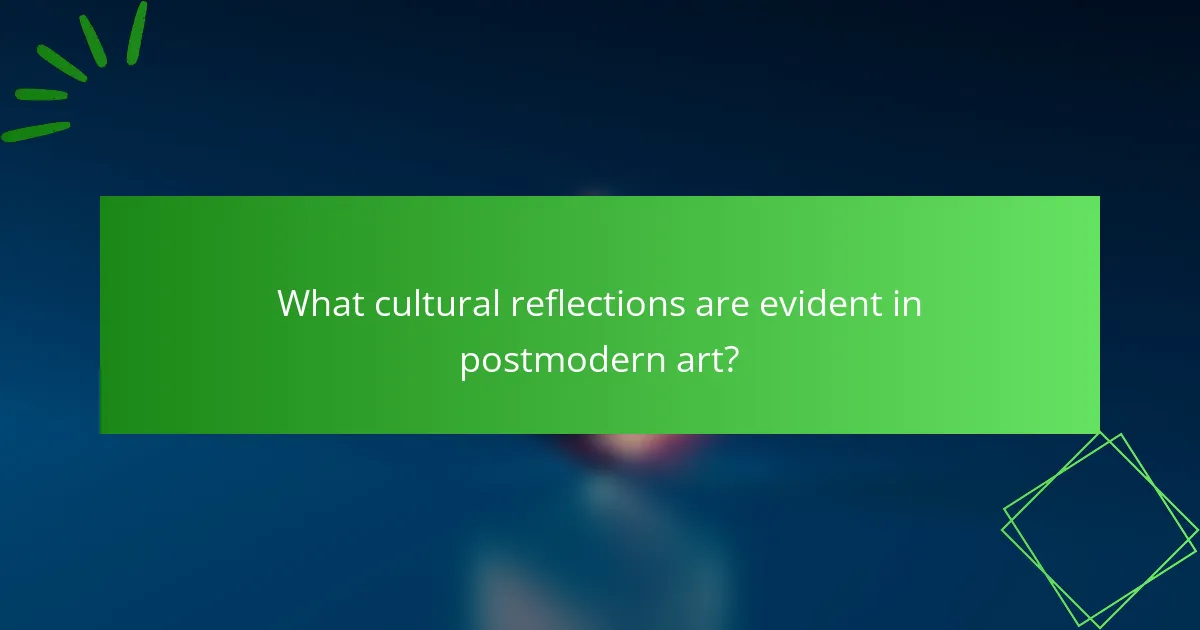
What cultural reflections are evident in postmodern art?
Postmodern art reflects cultural diversity, irony, and fragmentation. It challenges traditional narratives, incorporating various media and perspectives. Artists often critique consumerism and societal norms. The use of pastiche highlights the blending of styles, showcasing a unique attribute of postmodernism. This art movement embodies a rare engagement with global issues, emphasizing inclusivity and multiplicity in cultural expression.
How does postmodern art critique consumer culture?
Postmodern art critiques consumer culture by subverting traditional values and questioning materialism. It employs irony, parody, and pastiche to highlight the absurdity of consumerism. Artists like Andy Warhol used commercial techniques to blur the lines between art and advertising, reflecting society’s obsession with brands. This approach reveals the emptiness behind consumer desires, encouraging viewers to reconsider their relationship with material goods.
What themes of identity and representation are explored in postmodern art?
Postmodern art explores themes of identity and representation through fragmentation, irony, and diverse perspectives. Artists challenge traditional notions of self, often incorporating multiple identities and cultural references. This approach reflects a broader societal shift towards inclusivity and the questioning of established narratives. The use of mixed media and appropriation allows for a complex interplay of voices, emphasizing the fluidity of identity in contemporary culture.
How does postmodern art respond to technological advancements?
Postmodern art critically engages with technological advancements by reflecting on their impact on culture and society. Artists often incorporate digital media, challenging traditional forms and questioning authenticity. This evolution highlights the tension between technology and human experience, emphasizing the unique attribute of postmodern art as a commentary on contemporary life. The integration of new technologies allows for innovative expressions, blurring the lines between art and everyday life. As a result, postmodern art serves as a mirror, revealing the complexities of a technology-driven world.
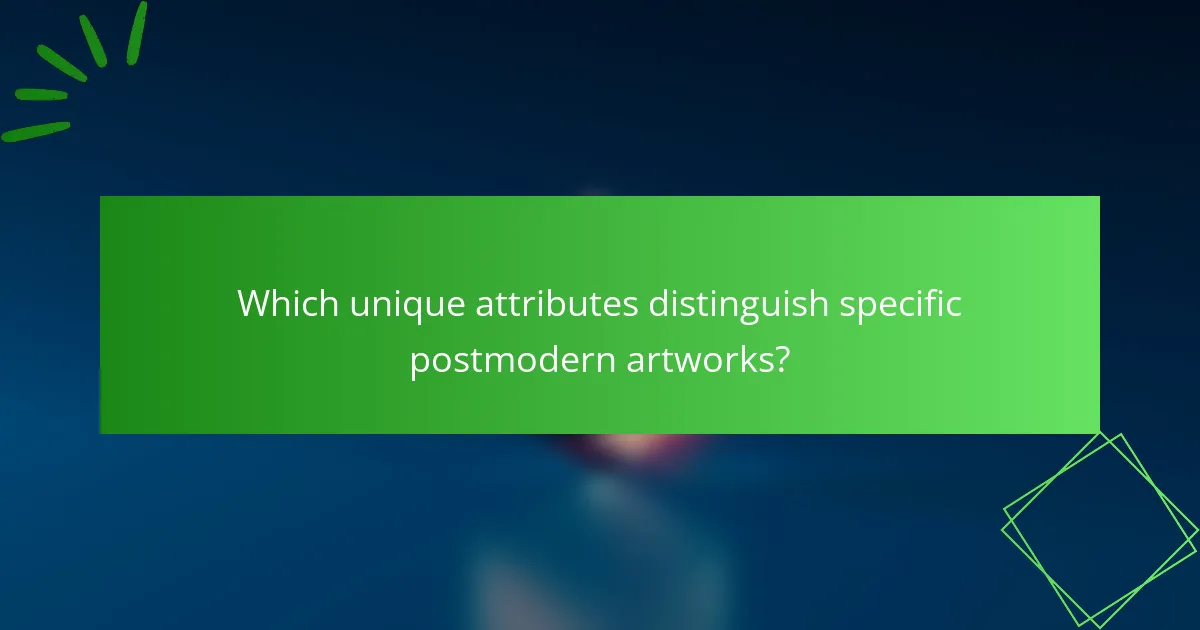
Which unique attributes distinguish specific postmodern artworks?
Unique attributes that distinguish specific postmodern artworks include irony, pastiche, and fragmentation. These traits challenge traditional aesthetics and embrace multiple perspectives. For example, artworks often blend different styles and mediums, reflecting cultural diversity. Additionally, the use of appropriation allows artists to comment on societal issues, creating a dialogue between the original and the new. This approach highlights the unique attribute of self-referentiality, where the artwork acknowledges its own status as art.
What makes certain postmodern pieces iconic?
Certain postmodern pieces become iconic due to their unique ability to challenge traditional norms and provoke thought. Their distinctive characteristics, such as irony, pastiche, and self-referentiality, resonate deeply within cultural contexts. These artworks often reflect societal issues, making them relevant and impactful. The evolution of postmodernism, marked by diverse forms and mediums, contributes to the lasting significance of these pieces in contemporary discussions.
How do regional variations manifest in postmodern art?
Regional variations in postmodern art reflect diverse cultural influences and local contexts. Different regions express unique artistic narratives, often shaped by historical, social, and political factors. For instance, American postmodern art frequently emphasizes consumerism and identity, while European counterparts may focus on deconstruction and irony. In Asia, postmodern art often blends traditional motifs with contemporary themes, showcasing a unique fusion of past and present. These variations highlight how local cultures interpret and challenge global artistic movements.
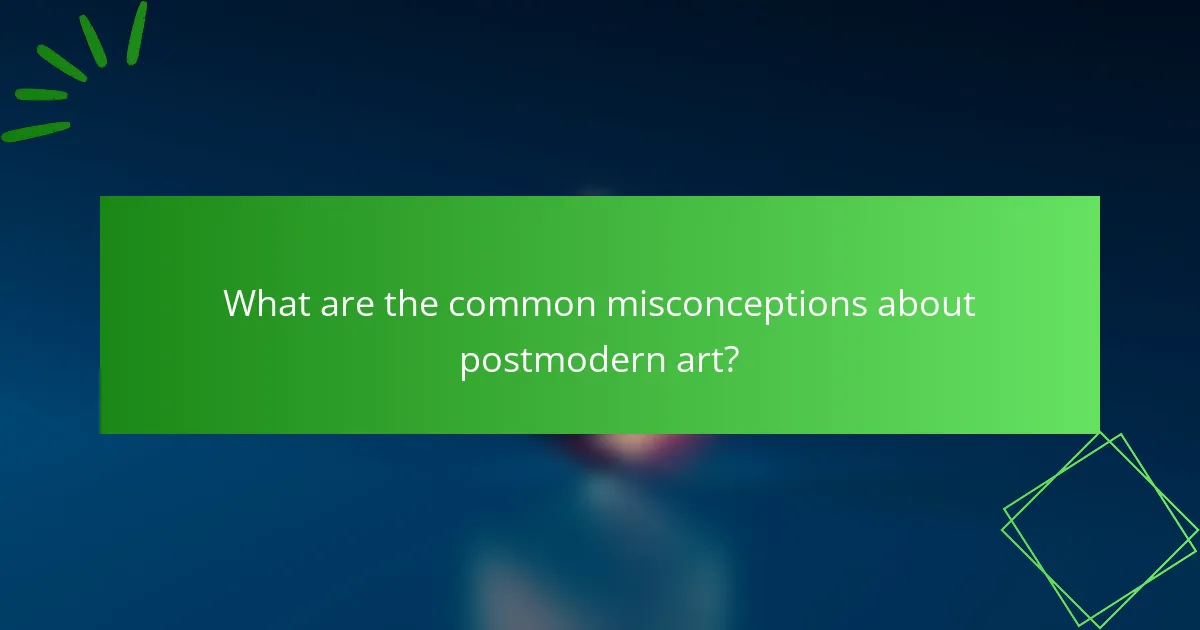
What are the common misconceptions about postmodern art?
Common misconceptions about postmodern art include the belief that it lacks meaning, is purely subjective, or is just a rejection of modernism. Many think postmodern art is chaotic and random, overlooking its intentional critique of established norms. Another misconception is that all postmodern art is commercialized, ignoring the depth of social commentary often present. Additionally, some assume that postmodern artists do not possess technical skills, while in reality, many are highly trained. Understanding these misconceptions helps appreciate the complexity and cultural reflections of postmodern art.
Why do some critics dismiss postmodern art?
Critics often dismiss postmodern art due to its perceived lack of meaning and coherence. They argue that its emphasis on irony, pastiche, and fragmentation undermines traditional artistic values. This skepticism stems from postmodernism’s challenge to established narratives and its focus on subjective interpretation. Additionally, some view postmodern art as elitist, alienating audiences unfamiliar with its concepts.
How can understanding context change perceptions of postmodern art?
Understanding context can significantly alter perceptions of postmodern art by revealing deeper meanings and cultural critiques. Context shapes how viewers interpret the fragmented, often paradoxical nature of postmodern works. For instance, knowing the historical background or the artist’s intent can shift a piece from mere chaos to a commentary on societal issues. Additionally, the interplay of different media and styles in postmodern art reflects a diverse cultural landscape, inviting viewers to engage with multiple perspectives. This layered understanding fosters a richer appreciation and encourages dialogue about the complexities inherent in postmodern expressions.
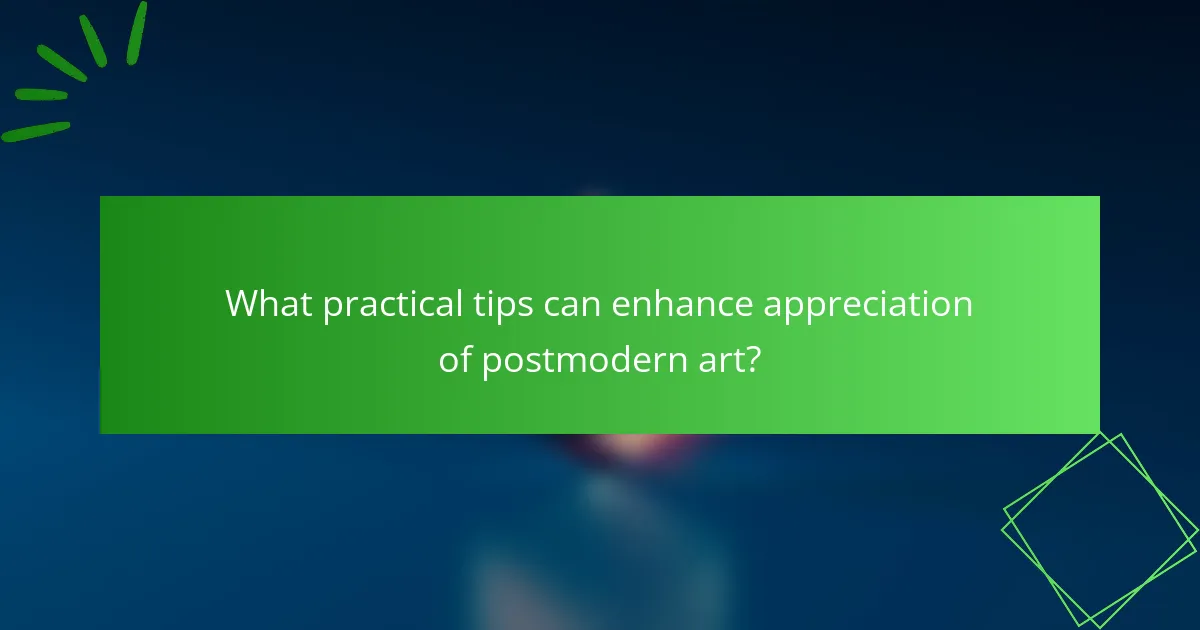
What practical tips can enhance appreciation of postmodern art?
To enhance appreciation of postmodern art, engage actively with its diverse forms and concepts. Explore various mediums, attend exhibitions, and participate in discussions. Analyze the cultural context and critique the underlying themes. Reflect on personal interpretations and emotions evoked by the artwork. Consider the artist’s background and the socio-political influences on their work.
How to approach viewing postmodern art for the first time?
To approach viewing postmodern art for the first time, focus on openness and exploration. Engage with the art without preconceived notions. Consider the context, as postmodern art often challenges traditional narratives. Look for unique attributes, such as irony or parody, which are frequently present. Reflect on personal interpretations, as meaning can vary widely among viewers. Embrace the experience as a dialogue rather than a fixed interpretation.
What resources can deepen understanding of postmodern art?
To deepen understanding of postmodern art, explore diverse resources including books, documentaries, exhibitions, and online courses. Key texts like “Postmodernism: A Very Short Introduction” provide foundational insights. Documentaries such as “The Shock of the New” showcase pivotal artists and movements. Visiting contemporary art galleries and museums offers firsthand experience of postmodern works. Online platforms like Coursera and Khan Academy offer structured courses on postmodern art history and theory. Engaging with these resources enhances appreciation and critical analysis of postmodern cultural reflections.
